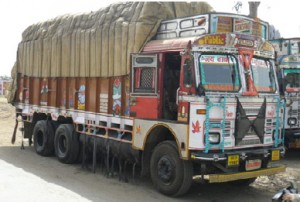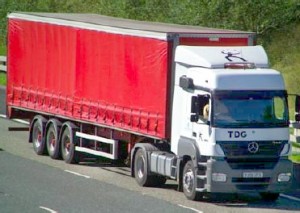Written for Kuehne Logistics University publication
Click here to download PDF of this blog
As a European logistics specialist travelling on the Indian road network for the first time, I was struck by the virtual absence of articulated trucks, comprising a tractor unit and trailer. Most of the road freight seems to be moving in small, open-topped rigid vehicles with two or three axles and brightly coloured liveries. In fact, at last count, they represented around 85% of all trucks on Indian roads. From a European perspective, the Indian road freight system may seem inefficient. After all, there are economies of scale in road haulage: the bigger and heavier the load, the lower are the unit transport costs per tonne‐km or cubic‐metre‐km.

Indian rigid truck
The standard Indian rigid trucks have a cubic capacity of around 30 m3 and gross weights ranging between 9 tonnes (on 2 axles) and 25 tonnes (on 3 axles).
By comparison, the main ‘workhorse’ of the European road freight sector is an articulated 5‐axle vehicle with a 13.6 metre trailer, offering 82 m of space and having a maximum gross weight of 40 tonnes.

European articulated truck
Surely then, it would be in India’s interests to move to a truck fleet more closely resembling that of European countries.
Not necessarily.
One must be cautious about recommending the transfer of logistics technologies from one country to another. There are often very good reasons, for example, for international differences in the composition of national truck fleets.
In several respects the Indian truck fleet is probably well adapted to the country’s physical and economic circumstances. Much of the country’s road infrastructure would be unable to accommodate articulated vehicles with large turning circles, while relatively few of the country’s factories, warehouses and shops have the reception facilities and manoeuvring space required by these vehicles.
Most Indian carriers would also lack the capital to acquire European‐style articulated vehicles. They are generally very small, predominantly owner‐driver businesses operating in an intensely competitive market, surviving on tiny margins and very low rates of return. Even if they were able to afford a large articulated vehicle, the nature of the Indian logistical system would not allow them to exploit the additional flexibility offered by ‘articulation’. In Europe there are typically around 1.7 trailers for every tractor unit allowing companies to decouple loading and transport operations. Most Indian truckers would lack the resources to acquire additional trailers and control their use. Perhaps the main explanation of the dearth of articulated trucks in India is that, at this stage in the country’s development, they are not actually needed. Bulky, primary products still make up a large proportion of the commodities moved by road. These are generally dense products that do not require the additional space that an articulated trailer offers.
Also, relatively little of the freight moved by road in India is conveyed on pallets or in roll cages, unitised handling equipment that takes up additional space. The very low labour costs in India make it more economical to ‘handball’ loose product, thereby maximising vehicle loading and eliminating the need for unitised and mechanised handling. Low labour rates also weaken the economy of scale argument for bigger trucks. In Europe the labour costs typically represent around a third of total road transport costs; in India it is around 10%. Procurement practices also influence the demand for road services and hence truck capacity. In many sectors, goods tend to be ordered in smaller quantities than in Europe reducing the need for large vehicles.
Although the current dominance of small rigid trucks can be explained and probably justified, it is likely that as the Indian economy develops, as its transport infrastructure is upgraded and as the logistics service sector evolves, greater numbers of articulated vehicles will appear on the roads. The Transport Corporation of India, the country’s largest logistics company, estimates that between 5 and 8 billion rupees (70 and 115 million Euros) could be saved annually if the national fleet of articulated trucks was increased by 10%. These savings would accrue mainly from reductions in fuel consumption and road wear and tear. The World Bank has also advocated a switch to articulated vehicles. Given the relatively long truck replacement cycle in India, however, it will probably several decades before India becomes as dependent on the articulated truck as European countries.



